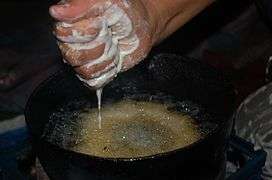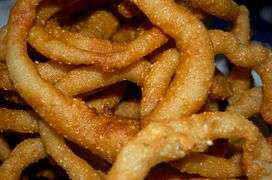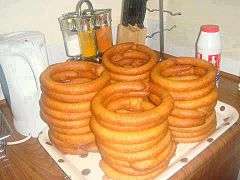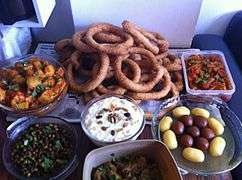Sel roti
 | |
| Type | Bread |
|---|---|
| Place of origin | Nepal |
| Region or state | All Nepal |
| Creator | Nepalese |
| Main ingredients | Rice flour, water, sugar, butter, cardamom, cloves |
|
| |
Sel roti (Nepali: सेल रोटी) is a Nepali traditional homemade, sweet, ring-shaped rice bread/doughnut. It is mostly prepared during Dashain and Tihar, widely celebrated Hindu festivals in Nepal and Darjeeling a part of India.
Preparation and ingredients
It is made of rice flour with adding customized flavours. A semi liquid rice flour dough is usually prepared by adding milk, water, cooking oil, sugar, ghee, butter, cardamom, cloves, bananas and other flavours of personal choice.[1] The ingredients are mixed well by stirring. Once the semi liquid dough is ready, it is deep fried in boiling oil or ghee.
The dough is poured by hand on home-made shortening or oil in ring shape and cooked on high heat until it turns light brown on both sides. Two sticks called jhir in the local language, each 1 foot (30 cm) long are used for turning the bread while cooking.[2]
Sel roti are cooked in bulk and can be stored at room temperature for least 20 days. Sel roti are often sent as special gifts to family members living away from home or used as prasad in puja.
-

The batter
-
Sel Roti cooking in progress
Occasions
Sel roti is a delicacy - made mainly for the great Nepali celebration of the Dashain and Tihar festivals. It is unique to Nepal and has become an iconic symbol of Nepali culture and festivities, and is made and served throughout the country during the festivals of Dasain, Tihar and Teej; and during wedding parties, bratabandha and other ceremonies. Sel roti is also a traditional food in Nepali-speaking communities in India, namely Darjeeling, Sikkim, Siliguri and Kalimpong. It is an essential food in most Nepalese cultural and traditional events.[3]
Gallery
-

Sel roti, Nepalese food
-

-

-
-

Nepali Cuisine
See also
References
External links
 Media related to Sel roti at Wikimedia Commons
Media related to Sel roti at Wikimedia Commons